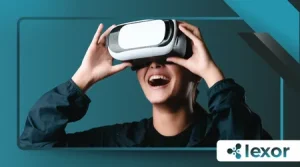VR in Real Estate: Virtual Tours and Smart Sales

VR in Real Estate is rapidly transforming how we buy and sell properties.
This immersive technology redefines the client experience, making property exploration more accessible and engaging than ever before.
It’s a game-changer for both buyers and sellers in a fiercely competitive market.
The New Frontier of Property Showings.
Gone are the days of rigid schedules and limited property viewings. Virtual reality liberates the real estate process.
Prospective buyers can now explore homes from anywhere, at any time, eliminating geographical barriers.
This revolution extends beyond simple convenience. It creates an unparalleled sense of presence. Imagine walking through a meticulously rendered 3D model of a home, feeling its spatial flow.
The ability to personalize these virtual experiences further enhances their appeal. Clients can visualize furniture placement or even experiment with different design schemes.
For busy professionals, this flexibility is invaluable. They can tour multiple properties in a single evening, all from the comfort of their living room.
Beyond the Open House: A Deeper Dive into VR Tours
Virtual tours offer more than static panoramas. They provide dynamic, interactive experiences. High-resolution graphics and realistic lighting make these digital environments incredibly lifelike.
Imagine zooming into intricate details, like crown molding or custom cabinetry. This level of scrutiny empowers buyers to make informed decisions.
Sellers benefit from wider reach and qualified leads. Their properties gain exposure to a global audience, attracting serious inquiries.
++Using Smart Cameras to Monitor Your Home Remotely
The data generated from these virtual interactions is also incredibly valuable. It provides insights into buyer preferences and engagement levels.
Consider the environmental impact, too. Fewer physical tours mean less travel, a small but significant step towards sustainability.
Enhancing the Sales Cycle with VR Intelligence

VR isn’t just about pretty pictures; it’s a powerful sales tool. It streamlines the sales funnel by pre-qualifying leads. Buyers who engage with virtual tours are often more committed.
Sales agents can leverage these virtual environments during presentations. They can highlight key features and answer questions in real-time.
This interactive approach fosters stronger client relationships. It demonstrates a forward-thinking and client-centric business model.
++The Future of Virtual Reality: What to Expect in the Next Decade
The ability to showcase future developments is another significant advantage. Buyers can explore properties that are still under construction.
This pre-visualization accelerates decision-making. It builds excitement and confidence in the unbuilt property.
The Economics of Immersive Experiences
Investing in VR technology yields significant returns. It reduces the need for expensive staging and multiple in-person visits.
The time saved by both agents and clients translates directly into cost efficiencies. It optimizes resource allocation within agencies.
++How Virtual Reality Is Used in the Military
Furthermore, properties with high-quality virtual tours often sell faster. They stand out in a crowded market, capturing buyer attention.
This speed to market is a major competitive advantage. It keeps inventory moving and capital flowing.
The perceived value of a property is also enhanced through professional VR presentations. It signals a modern and sophisticated approach.
Personalizing the Property Hunt
VR allows for unprecedented personalization. Buyers can customize virtual spaces to their taste. They can change wall colors or furniture styles with a click.
This “try before you buy” approach minimizes buyer’s remorse. It ensures the property truly aligns with their vision.
Agents can use this feature to upsell or cross-sell additional services. Imagine a design consultation integrated into the virtual tour.
This bespoke experience builds strong client loyalty. It makes the property search a truly enjoyable journey.
The emotional connection forged in a personalized virtual environment is profound. It transforms a house into a potential home.
The Future is Now: Beyond Basic Virtual Tours
The evolution of VR in Real Estate is continuous. Expect more sophisticated interactions and integrated data. We’re moving towards fully interactive digital twins of properties.
Imagine not just walking through a home, but interacting with smart home devices virtually. Turn lights on, adjust thermostats – all in the virtual space.
The integration of artificial intelligence will further enhance these experiences. AI could suggest properties based on previous virtual tour interactions.
Read more: Are Virtual Tours Still Worth It in Real Estate? Evidence from 75,000 Home Sales
Blockchain technology might even secure property transactions initiated within a VR environment. This adds a layer of trust and efficiency.
Augmented reality (AR) will also play a crucial role, bridging the gap between virtual and physical viewings. Imagine overlaying virtual furniture onto an empty room.
Overcoming Challenges and Embracing Innovation
While the benefits are clear, challenges remain. The initial investment in high-quality VR content can be substantial. Specialized equipment and skilled professionals are required.
Ensuring widespread access to VR headsets is another hurdle. Not all potential buyers own the necessary hardware.
However, the rapid advancement of technology is addressing these issues. More affordable headsets and browser-based VR are becoming common.
The learning curve for some clients might also be a factor. Simple, intuitive interfaces are crucial for widespread adoption.
Despite these obstacles, the transformative power of VR in Real Estate is undeniable. It’s an investment in the future.
Practical Applications and Real-World Impact
Consider a real estate developer launching a new luxury apartment complex.
Instead of building costly model units, they create a stunning virtual replica.
Prospective buyers can explore every floor plan, customize finishes, and even see the views from each balcony, long before construction is complete. This significantly speeds up pre-sales.
Another example: a busy international investor wants to purchase commercial property in a different time zone.
Instead of flying across the globe for multiple viewings, they take a comprehensive VR tour of several potential sites.
They can analyze the layout, surrounding infrastructure, and even traffic flow, making an informed decision without the need for extensive travel. This dramatically reduces transaction time and costs.
The Next Level of Engagement
Think of VR in Real Estate like a test drive for a car. You wouldn’t buy a car without sitting in it, feeling the steering, and experiencing its features.
Similarly, VR allows potential buyers to “test drive” a home.
They can navigate through rooms, gauge the spaciousness, and get a true feel for the property’s flow, much more effectively than looking at static photos or even a video.
It transforms a passive viewing into an active, personal exploration.
Why VR is Indispensable for Modern Real Estate
The question isn’t whether VR in Real Estate will become mainstream, but how quickly.
Are you prepared to offer your clients the future of property exploration? This technology is no longer a novelty; it’s a strategic imperative.
It empowers buyers with unprecedented information and convenience, while providing sellers with a powerful tool for global reach and efficient sales.
Embrace this innovation, and unlock new possibilities in the property market.
Frequently Asked Questions
What equipment do I need to offer VR tours?
Typically, a high-resolution 360-degree camera, specialized software for stitching images, and a platform to host the tours are needed. Some advanced setups may involve 3D modeling software and VR headsets for a truly immersive experience.
Are VR tours expensive to create?
The cost varies widely depending on the complexity and quality desired. Basic 360-degree tours can be relatively affordable, while highly realistic 3D models of unbuilt properties can be a significant investment. However, the return on investment through faster sales and wider reach often justifies the expense.
Can VR tours replace in-person showings entirely?
While VR tours significantly reduce the need for initial in-person viewings and can even facilitate remote transactions, for many buyers, a physical visit remains an important step before making a final decision. VR acts as a powerful pre-screening and engagement tool, not necessarily a full replacement.
How do VR tours help with properties under construction?
For properties that are still being built, VR allows developers to create highly realistic virtual models. This enables potential buyers to “walk through” and visualize the completed space, including layouts, finishes, and views, long before the physical structure is ready. This is invaluable for pre-sales and securing early commitments.
Is VR accessible to all potential buyers?
While the most immersive VR experiences require a headset, many virtual tours are now accessible through standard web browsers on desktops and mobile devices. This significantly expands their reach, making them available to a wider audience without specialized equipment.
